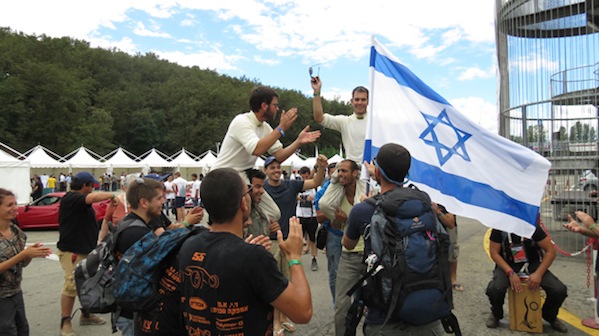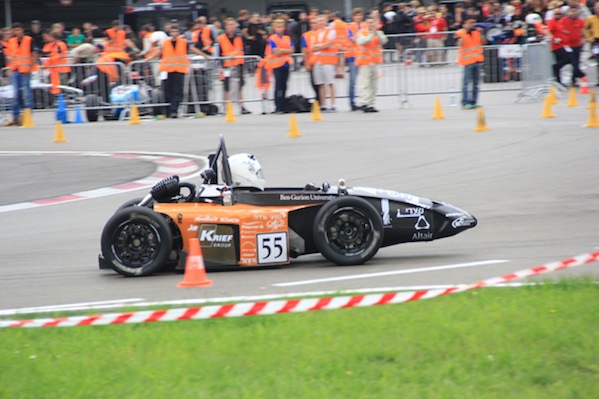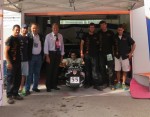In Italy, at Ben-Gurion Racing’s pit, from left to right, BGR2014 team leader Dudy Daud, project manager Tamir Plachinsky, main sponsor of the event Giampaolo Dallara, former EU president and former Italian prime minister Romano Prodi and the rest of the BGR team. (photo from BGR)
Israel is not known for manufacturing cars, let alone race cars, but that hasn’t stopped students from Ben-Gurion University from doing just that.
At their first race this year, in Austria Aug. 17-20, the car had an oil leak in the middle of the endurance race. “The car was stopped and we were very disappointed,” said mechanical engineer Tamir Plachinsky.
At the second race, however, in Italy Aug. 29-Sept. 1, the team fared better. They finished 21st overall out of 44 teams, completing all of the events, including acceleration, skid pad, autocross and hard endurance (which was incomplete in Austria).
“The team is extremely happy to have finished the event,” said Plachinsky. “We showed again the strength of our students – that, even in a year like we had [in Israel], we managed to build the most advanced car we’ve ever built and to race it in two races.”
Plachinsky began the initiative to build the first-ever Israeli Formula SAE project in 2010. After the successful participation of the first Ben-Gurion Racing (BGR) team in 2011 in the Italian race, Plachinsky was granted a six-month apprentice opportunity at the Italian racecar manufacturer Dallara. Upon his return, he started managing the race-car project at the university.

This year’s car is the fourth that students have designed and manufactured in the team. The aim is to redesign a new car each year for the Italian event, with a new group of students to replace the graduate students who have completed their studies.
“Each year starts with a new team and new goals, and you never know what will happen until the race,” said Plachinsky. “Think of it like a manufacturing company that forms at the beginning of the year with a new CEO … and everything [is] needed. And, at the end of the year, all the personnel retire from the company and you hire completely new staff.”
This year, Plachinsky said, “We started with new goals for the team and we knew we wouldn’t have enough time and resources to complete the car, but we still worked as hard as possible to keep to the time table and find support.”
The creation of the team occurs around September. The new team meets with the old team and learns about the current car. “We go over the good systems and the bad ones, where we need to improve and develop, and what should be left as is,” explained Plachinsky.
For 2014, the team consisted of 31 mechanical engineering students together with five students from the university’s department of management and design students from Bezalel Academy of Arts and Design in Jerusalem.
“We’re confident and believe in our ability to face any difficulty we’ll encounter,” said Plachinsky.
This year’s design concept was formed in September 2013. “They put into it their previous three years’ experience and a lot of courage to make it a better car from the 2013 model – one that put a new standard for race cars produced in Israel,” said Plachinsky.
This car, dubbed the “BGR14004,” had two unique features. The main frame is built from carbon fibre, instead of welded steel tubes, and the students designed their own gearbox.
“The carbon frame, also called ‘monocoque’ (Latin for ‘single shell’) is the first of its kind ever produced in Israel and allows for [a] lighter and stiffer chassis,” said Plachinsky. This is a feature the university students have been developing over the past two years.
“Together with the frame, we managed to design and manufacture the new gearbox,” he added. “This will enable the car to access a much better power supply, giving the driver help in reducing lap times.”
The main assembly was done in the university’s new compound, but the different parts were manufactured at various factories supporting the team. The carbon fibre frame was made at Composite Materials Ltd. in Modi’in, the gears were made at Ashot Ashkelon Industries Ltd. in Ashkelon, and the 3D-printed intake manifold was made at Aran Research & Development Ltd. in Caesaria. “But, as much as possible, we’re trying to keep the manufacturing of the parts in the Be’er Sheva area and the south of Israel,” said Plachinsky.
In competition

Registration for the races in Italy and Austria was in January 2014. “Once we knew we had spots at those events, all that was left to do was to build the car,” said Plachinsky. “This [was] no easy task, especially this year, because of the complicated manufacturing of the new frame and also – and maybe mainly – due to the fact that almost half the team got recruited to serve in the army. Even with these difficulties, we managed to complete the car just in time for the Austrian event, after a month of working 25 hours a day.”
Overall, Plachinsky said everyone is very happy with how the car performs. “It shows all the features we designed into it and is faster than last year’s car,” he said. “The students’ devotion to complete the car and represent the team, the university and the country in the best way possible has just been unbelievable.
“Arriving at the event with the car you’ve designed and built is an amazing feeling,” he continued. “Adding to that is the fact that the Austrian event is held at the famous Red-Bull Ring and that the Italian event, our traditional race, is always an amazing experience.”
The financial side
Getting the funding necessary for such a project is daunting – and most participating teams get 10 times the funding that BGR does, according to Plachinsky.
“We received support from the university and some companies and factories (from 2013 and continuing into 2014) but, as the design level goes up, so does the need for support,” he said. “Also, as we’re now on tour in Europe for three weeks; it’s not cheap or easy to organize and finance.”
Plachinsky and the team are approaching companies in Israel that they feel will want to collaborate with them “on a joint development basis or for marketing interest.” He said, “We want to show them how amazing this project is and that they can earn something by supporting us, having there be positive publicity, connections to the university, future employees, and so on.”
Plachinsky said of donors, “None of what we do would happen if it wasn’t for the good hearts of those people. We’ll be forever grateful.”
Looking ahead, the team’s goal is, as always, to advance into new areas and technologies. For the coming year, the plan is to participate in the Austrian and Italian events once again. This time, with a new car that will be the first electric race car made in Israel.
Although the team has not yet begun building it, the general concept is in place. “Some team members from next year’s team are here with us [in Italy], learning about the competition, the race and the car as much as possible before the current team will clear the stage for them,” said Plachinsky.
BGR is continually seeking assistance in helping them “represent Israel in the most amazing way and to educate the future engineers and automotive industry of Israel,” said Plachinsky. “And, for this, we greatly need to find further financial support.”
Rebeca Kuropatwa is a Winnipeg freelance writer.


Proud to be the father of one of the students.